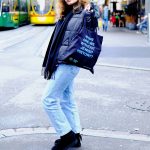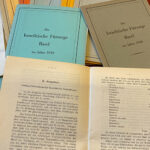Art in the Museum Courtyard
A Conversation with
Fabio Luks
Stones and Their Stories
Fabio Luks in conversation with Dr. Naomi Lubrich, the director of the Jewish Museum of Switzerland.
NL: Mr Luks, you are a conceptual artist. You produce words, you comment on spaces. At the Kunsthaus Grenchen you installed the word «Jetzt» [now] in human-sized letters that appear to be melting. For an installation in the courtyard of the Jewish Museum of Switzerland, where medieval gravestones are on permanent display, you built new gravestones inscribed with the Hebrew word «chai» [alive]. Is this reduction – or is it irony?
FL: You’re definitely right with «irony»: I’m reading a book that argues that art, like wit, needs a punch line. The point of CHAI is that gravestones commemorate the dead while simultaneously keeping them alive, by preserving their memory. And you’re also right about «reduction.» My work has become more concise over the years. I initially formulated whole trains of thought. Then, I reduced them to phrases. Now it’s just words. Since I started making art, my texts have gotten shorter.
NL: You mean like «gravestones that speak of life» to «alive»?
FL: The word «chai,» meaning «alive,» immediately came to my mind for the installation in the museum courtyard. Life has the highest possible value in Judaism. It is to be protected at all cost. And life is closely connected with words. You might remember that the Golem comes to life by means of a word. He’s made of clay, but when Rabbi Löw engraves magic letters into the mud, he awakens. In a way, gravestones are no different. Eight hundred years ago, the names of the dead were written on stones. Today, their inscription gives the stones a purpose, a significance, and a life of their own. Words turn this block of stone into a testimony to men and women who lived long ago.
NL: How did you become an artist? What was it that made you want to produce words in three dimensions?
FL: I began by painting textual images. I wrote down my arbitrary thoughts, like automatic writing. But I became more interested in the texts, less in the pictures. I wanted to capture the moment and hold it in words. I wanted to address the viewers directly. I looked for words that were ambiguous and playful. Soon I decided to do away with the pictures and concentrate just on the text. It was a kind of self-imposed restriction.
NL: Restrictions can stimulate creativity…
FL: (Laughs). So you say! Maybe I’ll go back to figurative images, because restrictions might make me creative, but only for a short time.
NL: Who are your role models?
FL: I am particularly interested in 20th century artists: Marcel Duchamp, the Nouveaux Réalistes, Jean Tinguely, Daniel Spoerri’s trap paintings [Fallenbilder], Pop Art, Martin Kippenberger, Jean-Michel Basquiat and Thomas Hirschhorn. They are the panorama of my «male influence,» if you like.
NL: They are artists with a sense of humour.
FL: Yes!
NL: You studied philosophy and Jewish studies in Basel. How did your studies influence your art?
FL: Both philosophy and Jewish studies are text-loving subjects. They are associative, conceptual. In class, we discussed authorship, testimonies, notes. We spent whole seminars on questions such as «What is an instant?,» «Can you hold on to it?,» «Is there a ‹now that isn’t always gone?» These are the topics I deal with in my work.
NL: And Jewish studies?
FL: Rejecting images, reflecting on texts – I’d call that an ideal-typical Jewish process.
NL: Is aniconism a topic of scholarly debate in Jewish studies?
FL: I knew about aniconism [the second commandment which prohibits making graven images] before my studies, but I never thought about it until I began to work as an artist. Judaism is most compatible with abstract art. But an artist like Chagall would certainly have seen it differently.
NL: Jews are still referred to as «people of the book.»
FL: I often think of Heinrich Heine’s concept of the «portable fatherland.» Language and texts shape our lives in ways that never cease to fascinate me. We live in our fictions.
NL: And identity, one of the defining themes of our era? In your art, I don’t see you exploring your own particularism.
FL: That may come yet! (Laughs). I am actually developing a project on identity. Not my own personal identity, but the identity of artists and their role in society. Unlike the great masters, artists today don’t have a clearly defined occupation. Most artists can’t live from their art. At the same time, art schools are training and graduating increasing numbers of students. Society’s expectations of art are huge.
NL: The artist as a modern messiah? In any case, your work is not purely «Jewish.» You refer to many other traditions. For instance, the colors of the panels are taken from the book A Dictionary of Color Combinations by Sanzo Wada. Is your referencing consciously postmodern? Or is it a reflection of our time, in which constant and varied referencing is the norm?
FL: I am open to various artists, sources and ideas and do not want to decide every detail myself. I use tools and don’t want to rack my brain. I quote consciously and subconsciously – it’s how I work.
NL: In our age of information, you produce analog objects by hand. Your art is not digital, you don’t make use of 3‑D printing. Your art is crafted in the same way that people carved stones in Biblical times. Is this part of your artistic concept?
FL: Well, it’s not really like in Biblical times. (Laughs). And at the risk of disappointing you, the materials I use are in fact new and innovative. They’re hardened foam boards that are light and easy to carve. I coat them with acrystal and paint them with acrylic. And I actually do make visualizations on the screen. I wouldn’t be averse to using a 3‑D printer either, should a project arise for which 3‑D printing would be useful (and affordable). But I wouldn’t want to work exclusively on the computer. I like physical labour. And definitely dialog – even interviews.
NL: I’ll take that as a compliment. Thank you very much for your time.
verfasst am 17.12.2021



